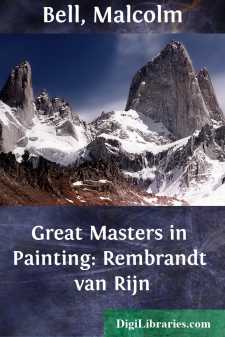Categories
- Antiques & Collectibles 13
- Architecture 36
- Art 48
- Bibles 22
- Biography & Autobiography 813
- Body, Mind & Spirit 142
- Business & Economics 28
- Children's Books 17
- Children's Fiction 14
- Computers 4
- Cooking 94
- Crafts & Hobbies 4
- Drama 346
- Education 46
- Family & Relationships 57
- Fiction 11829
- Games 19
- Gardening 17
- Health & Fitness 34
- History 1377
- House & Home 1
- Humor 147
- Juvenile Fiction 1873
- Juvenile Nonfiction 202
- Language Arts & Disciplines 88
- Law 16
- Literary Collections 686
- Literary Criticism 179
- Mathematics 13
- Medical 41
- Music 40
- Nature 179
- Non-Classifiable 1768
- Performing Arts 7
- Periodicals 1453
- Philosophy 64
- Photography 2
- Poetry 896
- Political Science 203
- Psychology 42
- Reference 154
- Religion 513
- Science 126
- Self-Help 84
- Social Science 81
- Sports & Recreation 34
- Study Aids 3
- Technology & Engineering 59
- Transportation 23
- Travel 463
- True Crime 29
Great Masters in Painting: Rembrandt van Rijn
by: Malcolm Bell
Description:
Excerpt
CHAPTER I
BIRTH AND EARLY YEARS
Down to the middle of the present century the story of Rembrandt, as generally accepted, was nothing but a mass of more or less ill-natured fiction. His drunkenness, his luxury, his immorality, his avarice, were heaped together into a somewhat inconsistent midden-heap of infamy. It was not indeed until his true rank among painters began to be properly appreciated that it occurred to anyone to ask whether this harsh judgment did not need revision; nay, more, to inquire upon what evidence it had been first delivered, and the investigation had not long been set on foot before the question took the form—"Is there any evidence, good or bad, at all?"
There were soon many workers in this untried field, and to all the thanks of the artist's admirers are due, but it is chiefly to M. Charles Vosmaer that his complete rehabilitation is to be credited, and it is bare justice to say that without availing himself freely of his researches and of M. Michel's equally careful and critical marshalling of the facts, then and since obtained by others, no future historian of Rembrandt can hope to advance beyond the threshold of his subject. One by one the cobwebs of myth with which, partly through malice, partly through ignorance, the master's image had been overwhelmed have been torn away, and we begin at last to see him as he really was, not impeccable, but intensely human, a kindly, patient, laborious, much-tried soul—one whom fortune, not altogether without his own provoking be it frankly owned, sorely buffeted, but one who, though well-nigh crushed, was never subdued; one whose courage sustained him to the last, whose one refuge against her flouts was in his art; who met, uncomplaining, neglect and contempt in his later years as he had in the heyday of his career received, unspoiled, unstinted praise and well-earned fame, and who said of himself in the height of his prosperity, "When I want rest for my mind, it is not honours I crave, but liberty."
Much concerning Rembrandt has been revealed by M. Vosmaer and his fellow-workers, by MM. Bredius and Scheltema, de Vries and Immerzeel, Elzevier and Eckhoff, van der Willigen, and other patient seekers, but much, nevertheless, still remains in doubt or darkness.
Even as to the date of his birth, there is considerable uncertainty. Orlers, a burgomaster of Leyden, in a description of that town published in 1641, and therefore while not only Rembrandt himself but many people who must have remembered his birth were still alive, states that Rembrandt, the son of Hermann, the son of Gerrit, and Neeltje, the daughter of Willems of Suydtbroeck, was born on the 15th of July 1606, and later writers for more than two hundred years accepted his assertion without question. Dr Bredius has, however, shown that on May 25th, 1620, Rembrandt was entered as a student in the Faculty of Letters at the University of Leyden and his age is given in the same document as fourteen, Rembrandt Hermanni Leidensis 14 jare oud, and as this was before his birthday in that year the question arises as to whether the statement means that he was in his fourteenth year or that he had passed the fourteenth anniversary of his birthday. For, the day of his birth not being in dispute, if we take the latter and more obvious interpretation it would necessarily follow that the fourteenth anniversary was in 1619 and that he completed his first year on 25th May 1606, so that the actual day itself must have been in 1605. There is further and still conflicting evidence to be reckoned with. In the British Museum there is a proof of an etched portrait of himself dated 1631 [B. 7], on which is written, in what is believed to be his own hand, "aet. 24, 1631." If this was written before the 15th of July it would point to 1606 as his birth year, thus agreeing with Orlers' statement, while if it was written after that day it would imply 1607. It should, however, be observed that M. Blanc reads the figures on the etching as 25, and if he be correct in this the choice must lie between 1607 and 1608; while, to add further to the mystification, Mr Sidney Colvin reads the age as 27, which makes the birth year 1603 or 1604....


